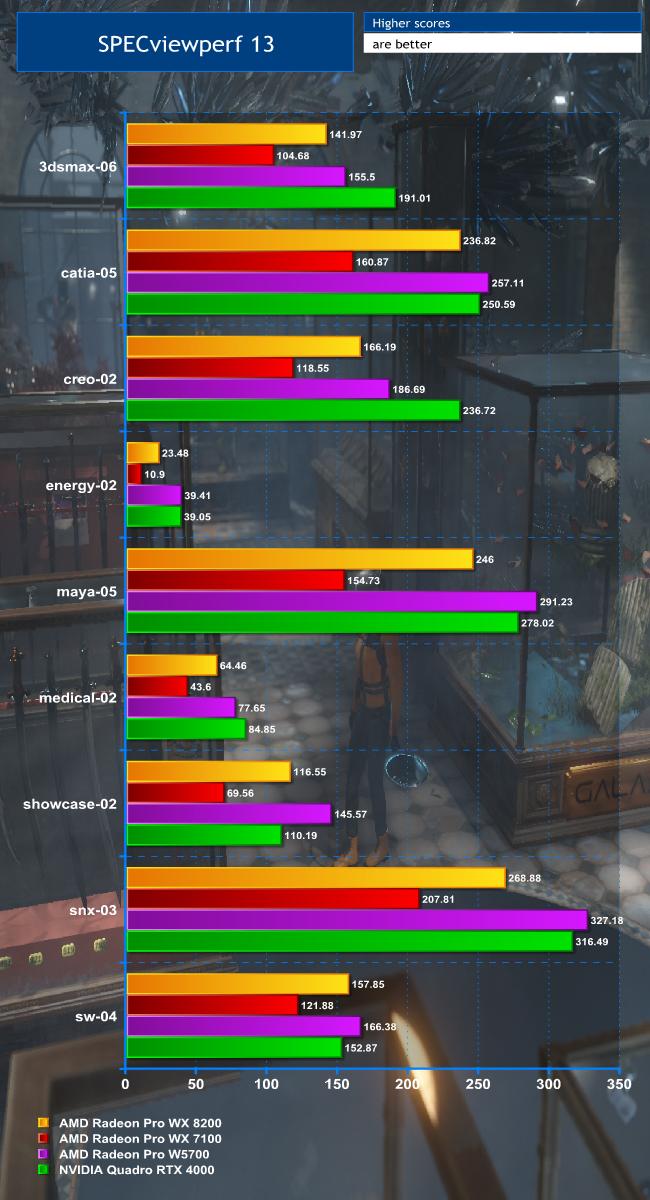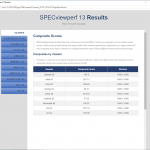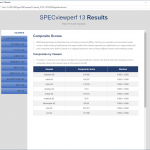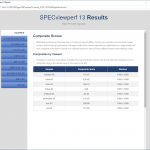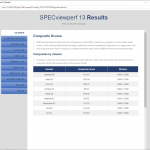SPECviewperf 13
The SPECviewperf 13 benchmark is the worldwide standard for measuring graphics performance based on professional applications. The benchmark measures the 3D graphics performance of systems running under the OpenGL and Direct X application programming interfaces. The benchmark’s workloads, called viewsets, represent graphics content and behavior from actual applications.
The latest version is SPECviewperf 13, released on May 23, 2018. SPECgpc members at the time of V13 release include AMD, Dell, Fujitsu, HP, Intel, Lenovo, and NVIDIA.
SPECviewperf 13 is a comprehensive upgrade of previous versions of the benchmark. Medical and energy viewsets incorporate new models and raycasting for volume visualization; the Maya viewset features new models based on the SPECapc for Maya 2017 benchmark; and the Creo viewset has been updated with fresh application traces. All other viewsets have been recompiled with minor changes. Results from SPECviewperf 13 are not comparable to those from earlier versions.
Other major updates in SPECviewperf 13 include:
- Support for 4K resolution displays.
- New reporting methods, including JSON output that enables more robust and flexible result parsing.
- A new user interface that will be standardized across all SPEC/GWPG benchmarks.
- New workloads and scoring that reflect the range of activities found in real-world applications.
- Various bug fixes and performance improvements.
This is arguably the most important test we ran, and it's very good news for AMD in most cases.
The W5700 outperforms its WX 7100 and 8200 very respectably with the 3dsmax-06 viewset, beating the 8200 by nearly 10 per cent, but NVIDIA's Quadro RTX 4000 is 23 per cent faster still.
However, the catia-05 viewset is a different story. The W5700 is faster than all the other cards, beating the Quadro RTX 4000 by nearly 3 per cent.
Results swing back in NVIDIA's favour with the creo-02 viewset, where the Quadro RTX 4000 is 27 per cent faster, but the W5700 is still the quickest AMD card.
It's virtually neck-and-neck with the energy-02 viewset, whilst medical-02 gives the RTX 4000 another 9 per cent win. However, these tests don't correspond directly to specific branded software applications. The energy-02 viewset is based OpendTect seismic visualisation, whilst medical-02 simulates things like MRI scanner outputs.
With the maya-05 viewset, the W5700 again comes out on top, beating the Quadro RTX 4000 by 5 per cent.
The showcase-02 viewset is another one based on Autodesk software, in this case Showcase. AMD Radeon Pros are clearly well optimised for this, as both the WX 8200 and W5700 gain a jump on the NVIDIA Quadro RTX 4000. The W5700 is a sizeable 32 per cent in the lead.
The final two viewsets – snx-03 and sw-04 – are focused on CAD software used frequently for product design – Siemens NX and Solidworks respectively. It's reassuring to see that the W5700 is the leading performer in both. It's 3 per cent faster than the RTX 4000 in snx-03 and 9 per cent faster in sw-04.
The Radeon Pro W5700 is clearly a great card for CAD, engineering and product design with Siemens NX or Solidworks, and it's ahead of the RTX 4000 with Dassault Systemes CATIA as well. Only PTC Creo puts it behind the NVIDIA alternative.
For 3D animation, if you're using 3ds Max, then NVIDIA's Quadro RTX 4000 is the best choice. But for Maya, the AMD Radeon Pro W5700 takes the lead.
Overall, this is an impressive set of results considering that the W5700 is likely to be quite a bit cheaper than the RTX 4000 when it becomes available to buy. It renders the WX 8200 all but obsolete as well.
Be sure to check out our sponsors store EKWB here
 KitGuru KitGuru.net – Tech News | Hardware News | Hardware Reviews | IOS | Mobile | Gaming | Graphics Cards
KitGuru KitGuru.net – Tech News | Hardware News | Hardware Reviews | IOS | Mobile | Gaming | Graphics Cards


